 |
||
|
||
| ||
 Some time ago we discussed a video card from MSI on the NVIDIA GeForce3 processor. Recently the company has released a new version of its StarForce822. Thanks to a daughter card with VIVO (Video In, Video Out), we can easily tell the old version from the new one. Besides, the new revision has a different cooling device. Moreover, the company has changed the name and now instead of the StarForce822 (MS 8822) it is called MSI GF3 Pro-VT64D. The card we examined last time wasn't perfect since it was coupled with a cheap low-quality logic and lacked for any cooling for the memory. The today's situation is completely different. The card on the new revision of the StarForce822 looks much better and has its own unique features (like VIVO). Before we turn to the card in question I should remind you that the whole theoretical base connected with this GPU is concentrated in the following articles (here you can also learn the peculiarities of certain cards and find out how they operate in the latest benchmark tests).
Today we are going to test the MSI GF3 Pro-VT64D card, and in particular the GPU, with the DroneZmark test which is a part of the DroneZ game. It should be noted also that we have two such cards which differ only in the cooler's color. CardThe MSI GF3 Pro-VT64D (MS 8822) has AGP x2/x4 interface, 64 MB DDR SDRAM memory located in 8 chips on the right side of the PCB. 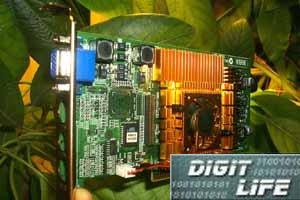 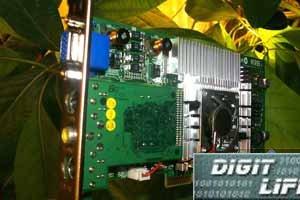 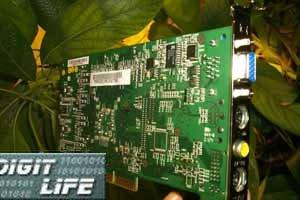 These cards, as I have said, differ in the color of the memory's and the GPU's coolers. So, you can get either golden heatsinks on a green card or silvery heatsinks on a green card :) EliteMT produces memory chips with 3.8 ns access time, which corresponds to 260 (520) MHz. Like all other GPU GeForce3 cards, this one works at 200/230 (460) MHz. The memory modules are covered with heatsinks that is why it is impossible to look at them. 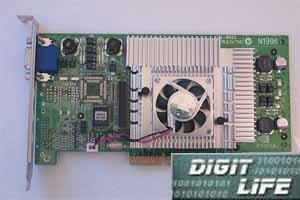 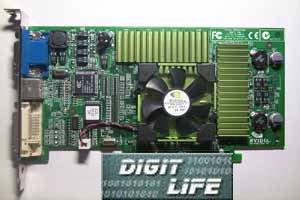 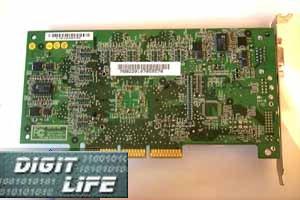 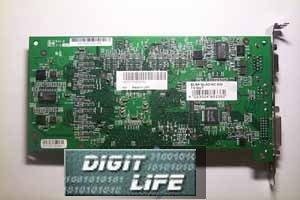 On the left you can see the MSI GF3 Pro-VT64D
(MS 8822), and on the right is the reference NVIDIA GeForce3 (represented
by the ELSA
Gladiac 920). You see that MSI doesn't deviate from the reference
design. The animated GIF below demonstrates the same fragment
of the card (a light green one is 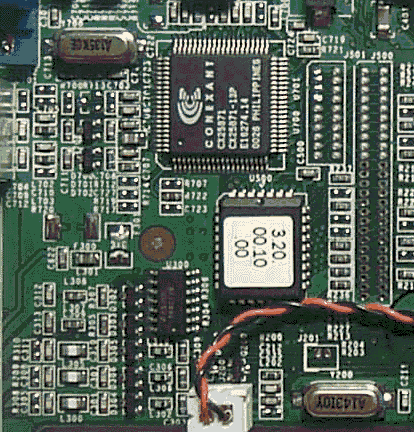 The difference consists only in a daughter card with the VIVO. A similar card with a device for receipt and sampling of an analog signal and for displaying it on a TV could be seen on the GeForce3 card from Gainward. The Philips module of the 7100 series is in charge of a signal conversion (it incorporates both a DAC and ADC). On the one hand, such a universal processor makes such daughter cards cheaper and increases the production volumes of video cards equipped with VIVO; on the other hand, the experience of ASUS V8200 Deluxe, Gainward GeForce2 MX400, Gainward GeForce3 VIVO and MSI GeForce2 MX400 cards show that the copy protection integrated into the coder makes impossible recording of even an amateur video clip. Unfortunately, not only licensed video cassettes are copy protected by the Macrovision system - amateur clips are also often protected from sampling. When you try to play it the image trembles. And I don't know whether it is possible to fix the bugs on the drivers' level (the card ships with NVIDIA WDM drivers for video capture). 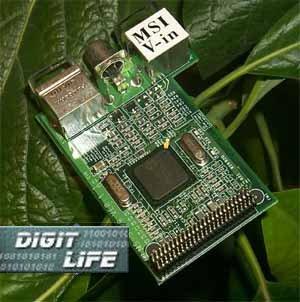 The daughter card has connectors for receipt/output of an analog signal. Unfortunately, while there are two connectors for TV-out (S-Video, RCA), the receipt and sampling is implemented only via the S-Video one. The company didn't supply the S-Video-to-RCA adapter, and none of ours suited the card, that is why we failed to test the VideoIn. 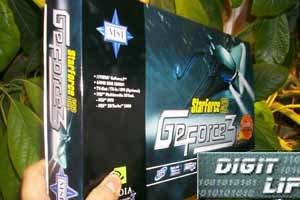 The card ships in a Retail package which includes:
OverclockingWith the additional cooling provided, both MSI GF3 Pro-VT64D (MS 8822) cards show an excellent overclocking potential - 250/275 (550) MHz. Note:
Installation and driversTest system configuration:
During the tests we used NVIDIA drivers of v14.61, VSync was off, the S3TC technology was enabled. For the comparative analyses we used the following cards:
Those who want the detailed information on the utilities supplied with the card should read the review of the MSI StarForce822 card. Test resultsLet's start with 2D. Almost all cards on this GPU have a very good 2D quality, though it strongly depends on a definite sample and on the quality and possibilities of your monitor. Expensive video cards (GeForce2 Pro and higher) based on the reference design from NVIDIA have sometimes defects in 2D, but a probability to come across such a card is much smaller than for Low-end cards. I have tested a dozen of GeForce3 cards and can state that their quality was never worse than that of Matrox G400, but you should use only a high-quality monitor! NVIDIA as a developer and a seller of chips (not cards!) is not able to keep an eye on the quality of components mounted by third companies on their cards, that is why 2D may differ much. But such deviation is much less on expensive models. The MSI GF3 Pro-VT64D (MS 8822) has very good 2D quality. Even in 1600X1200 at 85 Hz you can play comfortably (this resolution is exactly where the quality starts falling down as the resolution grows up). For estimation of 3D quality we used the DroneZ game from Zetha-Game. This game is supplied with some video cards and has a benchmark DroneZMark. DroneZThis game is based on the OpenGL, has a great deal of settings and complex graphics. The benchmark allows us to change settings. I used the GeForce2 Pro/Ultra preset (see the left photo) for all cards in question. All settings, above all, were set to maximum, i.e. all possible 3D functions and all detailing levels were enabled (see the photo on the right). 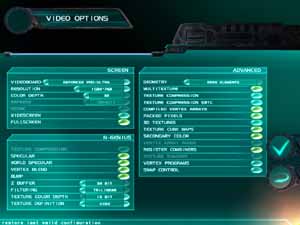 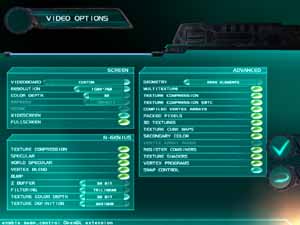 Before we proceed to the results I'd like to show you some screenshots from this game which demonstrate the effects and graphics in the DroneZ: 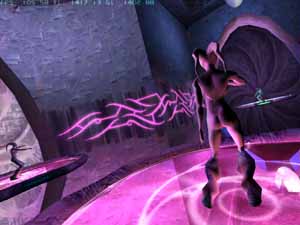  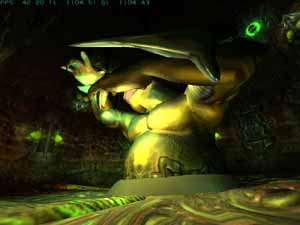 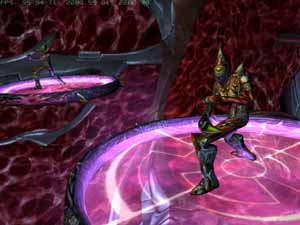  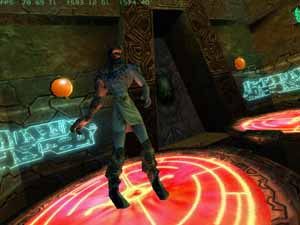 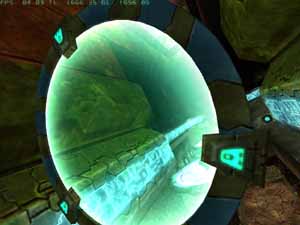  It is really impressing. Unfortunately, it is impossible to deliver relief and lighting effects in all their beauty. Now let me estimate the speed of still the most powerful accelerator. 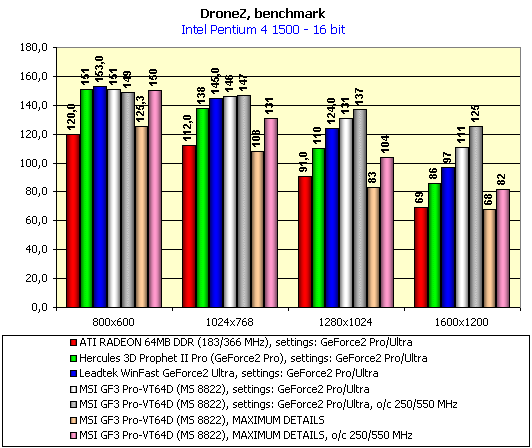 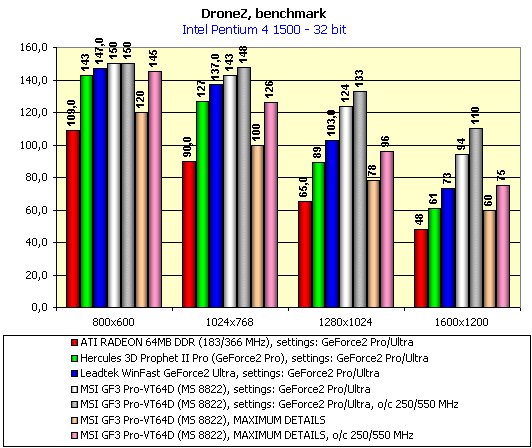 Despite such a heavy load the performance is fantastic! You might remember that in the AquaNox, quite a new game, the results were rather poor. The OpenGL seems to be able to adjust operation of the accelerator much better. The DirectX API doesn't excel in it. The DroneZ and AquaNox have both excellent graphics, and their effects are equally beautiful, but their performance levels are quite different. With 3D textures enabled and with usage of
vertex shaders on the The performance of the participants was exactly
what we expected. I was just surprised that the GeForce3 was more
efficient in 16-bit color than the In closing, I'd like to advise you to read also other reviews of GeForce3 based video cards. Besides, in our 3Digest you can find thorough information on the 3D performance of GeForce3 cards on different platforms. ConclusionToday we have examined just another version of the MSI StarForce822 card which changed a lot. While the previous card had a lot of disadvantages, this model is rather successful. The MSI GF3 Pro-VT64D is a decent card with normal cooling and with VIVO functions. The quality of the card has improved which also affected the 2D quality. The VideoIn worsens the general impression, and I hope we will soon get normal software where this function will be bugfixed. In our 3Digest you can find a full comparison of characteristics of cards of this and other classes. Highs:
Lows:
Write a comment below. No registration needed!
|
Platform · Video · Multimedia · Mobile · Other || About us & Privacy policy · Twitter · Facebook Copyright © Byrds Research & Publishing, Ltd., 1997–2011. All rights reserved. |